

Schematics. Eukaryotes. Discussion of Phylogenetic Relationships Our understanding of eukaryotic relationships has been transformed by the use of molecular data to reconstruct phylogenies (Sogin et al., 1986).
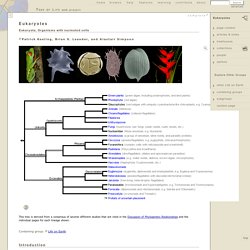
Prior to that, the diversity of microbial eukaryotes was vastly underestimated, and the relationships between them and multicellular eukaryotes were difficult to resolve (Taylor, 1978). Early molecular phylogenies based on small subunit ribosomal RNA (SSU rRNA) gene sequences suggested a ladder of basal lineages topped by a ‘crown’ composed of multicellular groups (animals, plants, and fungi) together with a subset of the purely microbial lineages (Sogin, 1989). Gathering Moss - Recherche Google. Lichens with in South America. Toltec. Temple of quetzalcoatl. Pyramid of sun. Western mexico 1800 bc. San lorenzo mesoamerica olmec art - Recherche Google. Olmec isthmus of tehuantepec. Olmec civilization. Calculate Them Here. Maya calendar - Recherche Google. Hellenize. Zapotec Civilization.
Home - Jane Goodall's Good For All News. Restoration of the world's wetlands - Recherche Google. Caravaggio - Recherche Google. Brazil: Land Policy and the Indigenous Movement. Brazilian Indians have taken advantage of the process of abertura ("opening," the process of political democratization initiated by President Joao Figueiredo in 1979) to make significant political gains.

But landowners and developers have not stood by idly, and the military government's growing tendency to see and administer land as a national security issue bodes ill for Indian interests. Octavio Ferreira Lima, the first civilian President of Brazil's National Indian Foundation (FUNAI) since 1979 and only the second civilian in the job in FUNAI's 17-year history, replaced Col. Paulo Moreira Leal, who resigned under pressure in July 1983.
The new President promptly replaced several highly-placed military officers in the agency with civilians. Dark Ages. Dark Ages or Dark Age may refer to:

Jane goodall - Google 検索. Royal Botanic Society. A design for the Royal Botanic Society Gardens in Regent's Park, London by Decimus Burton, 1840.
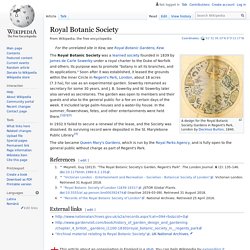
The Royal Botanic Society was a learned society founded in 1839 by James de Carle Sowerby under a royal charter to the Duke of Norfolk and others. Its purpose was to promote "botany in all its branches, and its applications. " Soon after it was established, it leased the grounds within the Inner Circle in Regent's Park, London, about 18 acres (7.3 ha), for use as an experimental garden. Sowerby remained as secretary for some 30 years, and J. B. Theophrastus. Life[edit] Most of the biographical information we have of Theophrastus was provided by Diogenes Laërtius' Lives and Opinions of Eminent Philosophers, written more than four hundred years after Theophrastus' time.[2] He was a native of Eresos in Lesbos.[3] His given name was Tyrtamus (Τύρταμος), but he later became known by the nickname "Theophrastus," given to him, it is said, by Aristotle to indicate the grace of his conversation (from Ancient Greek Θεός "god" and φράζειν "to phrase", i.e. divine expression).[4] Theophrastus presided over the Peripatetic school for thirty-five years,[12] and died at the age of eighty-five according to Diogenes.[13] He is said to have remarked "we die just when we are beginning to live".[14] Writings[edit]
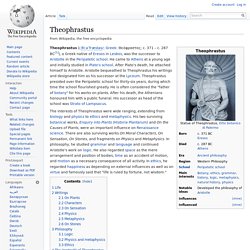
Tulip. While tulips had probably been cultivated in Asia from the tenth century, they did not come to the attention of the West until the sixteenth century, when Western diplomats to the Ottoman court observed and reported on them.
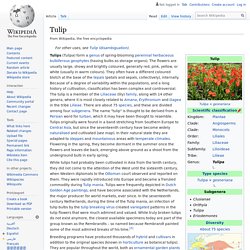
They were rapidly introduced into Europe and became a frenzied commodity during Tulip mania. Tulips were frequently depicted in Dutch Golden Age paintings, and have become associated with the Netherlands, the major producer for world markets, ever since. Hermann Hesse. German writer.
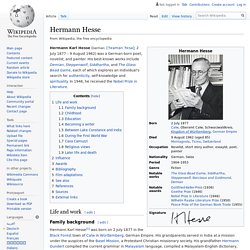
Ernst Haeckel. Ernst Heinrich Philipp August Haeckel (German: [ˈʔɛɐ̯nst ˈhɛkl̩]; 16 February 1834 – 9 August 1919[1]) was a German zoologist, naturalist, philosopher, physician, professor, marine biologist, and artist who discovered, described and named thousands of new species, mapped a genealogical tree relating all life forms, and coined many terms in biology, including ecology,[2] phylum,[3] phylogeny,[4] and Protista.[5] Haeckel promoted and popularised Charles Darwin's work[6] in Germany and developed the influential but no longer widely held recapitulation theory ("ontogeny recapitulates phylogeny") claiming that an individual organism's biological development, or ontogeny, parallels and summarises its species' evolutionary development, or phylogeny.

The published artwork of Haeckel includes over 100 detailed, multi-colour illustrations of animals and sea creatures, collected in his Kunstformen der Natur ("Art Forms of Nature"). Ernst haeckel tree if kife. Cs lewis voyage to venus. Julius von Mayer. Finnegans Wake by James Joyce. Finnegans Wake – Julia Gordon-Bramer. In the previous blog I mention Literary Alchemy, and the conscious effort that some poets and writers have made throughout history to interweave mysticism into their art in order to make it into something larger than themselves.

This is not a new idea, and I am not the first one to notice it. When Sylvia Plath was at Smith College, she spent a great deal of time working on a thesis on James Joyce’s Finnegans Wake. Thomas Mann. Paul Thomas Mann (UK: /ˈmæn/ MAN, US: /ˈmɑːn/ MAHN;[1] German: [ˈpaʊ̯l ˈtoːmas ˈman]; 6 June 1875 – 12 August 1955) was a German novelist, short story writer, social critic, philanthropist, essayist, and the 1929 Nobel Prize in Literature laureate.
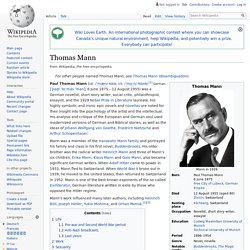
His highly symbolic and ironic epic novels and novellas are noted for their insight into the psychology of the artist and the intellectual. His analysis and critique of the European and German soul used modernized versions of German and Biblical stories, as well as the ideas of Johann Wolfgang von Goethe, Friedrich Nietzsche and Arthur Schopenhauer. Mann's work influenced many later authors, including Heinrich Böll, Joseph Heller, Yukio Mishima, and Orhan Pamuk.[2][3]
The Day of the Triffids. 1951 book by John Wyndham The Day of the Triffids is a 1951 post-apocalyptic novel by the English science fiction author John Wyndham. After most people in the world are blinded by an apparent meteor shower, an aggressive species of plant starts killing people. Although Wyndham had already published other novels using other pen name combinations drawn from his real name, this was the first novel published as "John Wyndham". It established him as an important writer and remains his best-known novel. The Day of the Triffids. John wyndham the day of the triffids. Julius von Mayer. E. O. Wilson. Edward Osborne "E. O. " Biophilia hypothesis. The biophilia hypothesis also called BET suggests that humans possess an innate tendency to seek connections with nature and other forms of life.[1] Edward O. Wilson introduced and popularized the hypothesis in his book, Biophilia (1984).[2] He defines biophilia as "the urge to affiliate with other forms of life".[3] Love of living systems[edit] The term "biophilia" means "love of life or living systems.
" It was first used by Erich Fromm to describe a psychological orientation of being attracted to all that is alive and vital.[4] Wilson uses the term in the same sense when he suggests that biophilia describes "the connections that human beings subconsciously seek with the rest of life. " He proposed the possibility that the deep affiliations humans have with other life forms and nature as a whole are rooted in our biology.